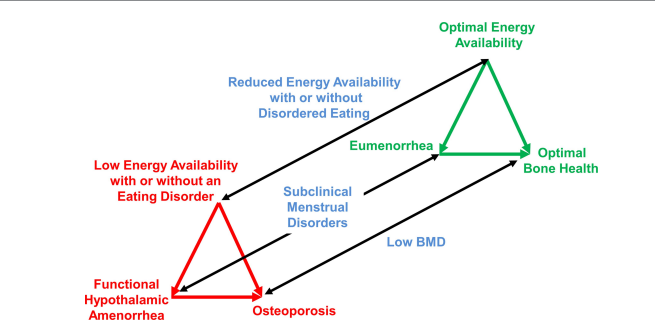At the 10th Annual Sanford Sports Medicine Symposium last weekend, I spoke about nutrition's role in injury prevention and recovery. One of the main topics of the presentation was low energy availability in athletes. Energy availability is the amount of calories left over for the body to use for normal physiological functions (heart beating, walking around, lungs breathing, thermoregulation, growth, etc.) after accounting for calories burned during training or exercise.
Food intake - Energy Expended During Exercise = Energy Availability
Athletes who have heavy training schedules can be living in a chronic state of low energy availability, where every calorie they eat at meals is burned off during exercise, leaving little to no calories for the body to perform those regular bodily functions.
When calorie intake doesn't match energy expenditure, this low energy availability can not only have negative effects on training and athletic performance, but can put athletes at risk for other health problems.
For female athletes, this low energy availability can lead to other health issues, such as low bone mineral density and menstrual function disorders in what is called the Female Athlete Triad. Physically active girls and women can experience any one of the 3 components, which are interrelated and occur along a spectrum of healthy to unhealthy (see picture below).
 |
| Source: 2014 Female Athlete Triad Coalition Consensus Statement on Treatment and Return to Play of the Female Athlete Triad. De Souza MJ, et al. Br J Sports Med 2014;48:289 |
Regardless of body fat and weight, athletes' low energy availabliy can trigger amenorrhea, and appropriate treatment depends on why the athlete is under-fueling.
- Unintentional fueling due to low appetite from heavy training, or they may have a hard time fitting in meals and snacks around a heavy training schedule.
- Some athletes are caught up in the diet culture of their sport (or society in general), trying to lose weight, with the goal of being better at their sport. They may take this too far and develop disordered eating habits, restricting intake of foods such as carbohydrates or animal protein, which can cause under-fueling and nutrient deficiencies.
- Some athletes' restrictive eating patterns and disordered eating can lead to eating disorders, which puts athletes at a greater risk for health problems, and requires a different approach to recovery.
Treatment of female athlete triad requires correcting the energy imbalance - increasing calorie intake and resting from exercise.
Female athletes are often surprised when they find out how many calories they need to be eating to fuel their bodies, and how few they are currently eating. Very active individuals usually need at least 3 meals and several snacks per day. To get a better idea of current intake, athletes can track their food using popular apps, such as MyFitnessPal or tools like the SuperTracker.Although these tools give athletes an idea of what they're doing now, working with a registered dietitian can take the guess work out of meal planning and give them more guidance to how many calories they really need to support training, and which foods they should be focusing on to really optimize their workouts and recover properly.
The total calories aren't the only thing that matter - girls and women can be deficient in several key nutrients:
- Vitamin D: spend more time outdoors, fortified breakfast cereal, milk, fatty fish like salmon, egg yolks or a vitamin
- Calcium: dairy such as milk, cheese, yogurt
- Iron: it's important to get screened for iron status, as many women, especially endurance athletes, tend to have low iron
- Healthy fats: focus on eating plenty of nuts (including peanut/almond butter!), seeds (flax, hemp, chia), olive oil, avocados, salmon
- Adequate protein: 20-25 grams per meal, 10-15 grams per snack in the form of lean protein (chicken, fish, lean beef), nuts, yogurt, milk, beans, peas and soy
- Energy-enhancing carbohydrates: the amount of carbs an athlete needs depends on their weight and what kind of sport they're in, but because carbs are our muscles' main fuel source, eating plenty of fruit, vegetables, whole grains, and potatoes is necessary to perform well and recover adequately.
When speaking with female athletes, it's important to emphasize that food is fuel!
It's a good thing to eat when you're hungry and to enjoy food. Eating more food doesn't necessarily equate to weight gain, and many times, it can actually lead to improved sport performance. If an athlete or parent of an athlete suspects they are having any of the issues discussed, they should talk to their doctor. There are other causes for amenorrhea, so it's important to consult with your doctor to rule out other causes! A Registered Dietitian can help athletes fuel their bodies properly to avoid issues related to female athlete triad and under-fueling for their sport.NPR || To Thrive, Female Athletes Need a Lot More Food
The Informed Appetite || Drink Milk, or Don't. But Maybe Read This First (#Science!)
New York Times || After 'The Biggest Loser,' Their Bodies Fought to Regain Weight
Yeah...Imma Eat That || The Hunger and Fullness Scale (AKA How to Stop Dieting)



No comments:
Post a Comment